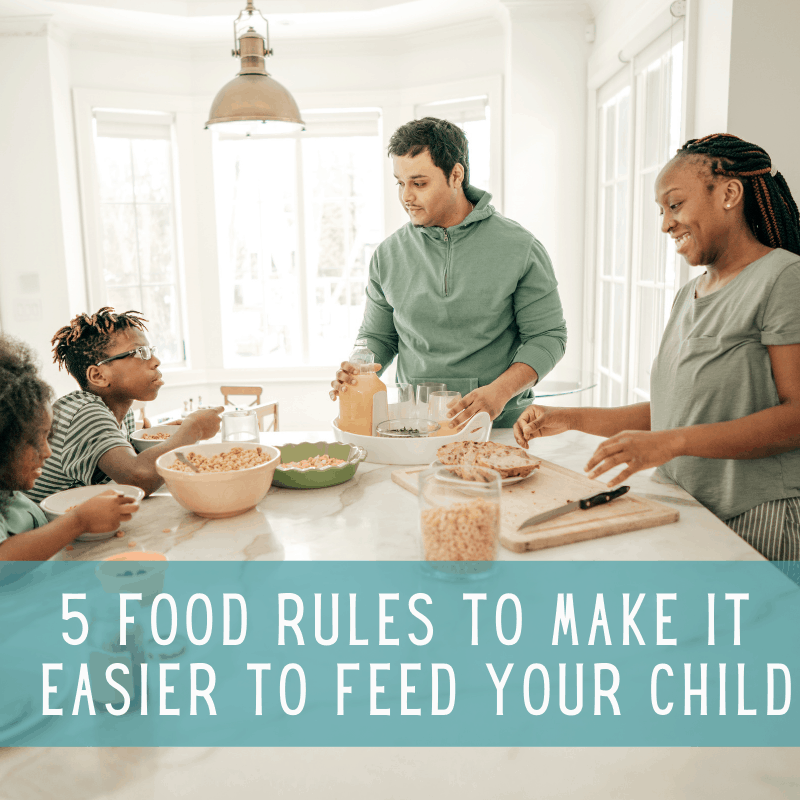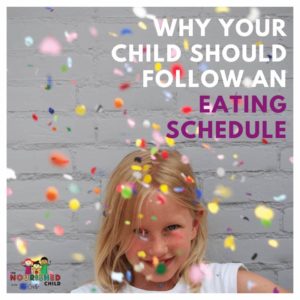These 5 Rules for Feeding Kids Make it Easier
February 15, 2021
Learn the basic rules for feeding kids that will make the whole endeavor easier, more pleasant and set your child up to be a healthy eater.
I get asked a lot of questions about feeding kids—of all ages! I find that much of my advice goes back to helping parents set rules for feeding kids, so I thought this post would help give practical tips for day-to-day feeding.
For more background on becoming an authoritative feeder, read my article on the four feeding styles and how to become more authoritative in your approach to feeding your child.
Hint: Authoritative feeding is the proven feeding style for success!

Rule #1: Use an “Ask First” Policy
I learned ‘ask before you take’—anything—when I was a kid. Maybe you’d call that a traditional or archaic way to approach raising or feeding children today, but I have carried on the tradition with my own children.
Not only does it extend to play dates/going out and borrowing clothes (yep, my teens do that now), it also involves eating, especially when it occurs off the usual schedule.
Remember, you are a nutritional gatekeeper and having your child ask first keeps you in charge. Equally important, when your child asks first, you are better able to monitor his eating—from how much is eaten to his food selection.
Sample Dialogue: “Are you hungry? If so, it’s polite to ask first before helping yourself. Let’s figure out together what we can do .”
Rule # 2: The Kitchen is Closed
My second rule for feeding kids revolves around closing the kitchen. This helps children eat with the structure and schedule you have created, and at the designated meal and snack time. It can also help curtail grazing and ultimately, excessive eating.
While it sends a clear message to children that eating occurs on a schedule, it also places the onus on the parent to stay on top of meals and snacks.
Sample Dialogue: “Lunch is over and the kitchen is closed. We’ll open back up at snack time, which is at 3 pm. Here, I’ll show you (on the clock) what 3 o’clock looks like.”
Rule #3: Create a Predictable Schedule
While you don’t have to be rigid about the timing of meals and snacks, a set schedule helps build predictability and rhythm with eating. It can also make a child feel more secure, not to mention, deliver the nutrition your child needs to learn and focus.
You’ll want to be flexible but not too loose. That is, allow some wiggle room around the timing of meals if needed, but don’t be unpredictable. Kids like to know when they can expect to eat, and generally what will be served.
For more about the frequency of meals and snacks as your child ages, read about an eating schedule.
Sample Dialogue: “We have a lot going on tonight, so dinner will be a little bit later than usual. You can expect to eat around 7 pm. You may want to have a bigger snack after school to carry you to dinnertime.”

Rule #4: Stay at the Helm
It’s not always easy to stay in the role of nutrition leader, but it’s important to fortify the rules for feeding kids. Sometimes children need a reminder of who’s in charge.
When your child turns into a teen, it may become even more important! Don’t be hesitant to have conversations about the Division of Responsibility with your child or teen, covering your role as provider and their role as consumer.
Sample Dialogue: “I appreciate that you want something else, but this is what we have on the menu today. You can choose to eat it or not. Let’s talk about how we can work in what you want over the next day or so. Will that work?”
Rule # 5: Allow Reasonable Choice
One of the cornerstones of being a good feeder is to give your child a voice when it comes to food preferences and amounts. But some parents make the mistake of giving too much choice, and that makes staying in charge harder.
A good feeding rule for kids related to this is to offer two or three choices within the same category. This is effective with all ages, as you can see below.
Reasonable choices give children the indication that you remain in control of feeding, but they have a say in the matter.
Sample Dialogue: “Would you like sweet potato or corn with dinner tonight?”
“Do you want me to make a plate for your late dinner, or do you want to gather it yourself from the fridge when you get home?”
“Before you leave for school, do you want a smoothie or toast with peanut butter?”
Do you have any feeding rules for yourself? Ones that you implement with your kids at home? What are they? Are they working?










